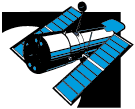The Physics Of Satellites
Eric W. / Physics 336 / 7 April 1997

Satellites have literally been around since the dawn of the space age.
Interest in satellites has been growing fast world wide. Businesses, government,
universities and other organization around the world are starting their
own satellite programs. Satellites are used for both exploration and communication.
Orbits
Many types of orbits exists, but most artificial satellites travel
in one of the three types: 1) Geosynchronous Orbit 2) Polar Orbit 3) Low
Earth Orbit (LEO). "Satellite orbits have a variety of shapes. Some
are circular, while others are highly elliptical. Orbits also vary in altitude.
Some circular orbits, for example, are just above the atmosphere at an
altitude of about 155 miles, while others are more than 20,000 miles above
earth" (Oberright 2).
Leos are either elliptical or circular orbits at a height of less than
2,000 km above the surface of the earth. The orbit period at these altitudes
varies between ninety minutes and two hours. A Geosynchronous Orbit is
any type of orbit which produces a repeating ground track. A satellite
in a geosynchronous orbit follows a circular over the equator at an altitude
of 35,800 km completing one orbit every 24 hours, in the time that it takes
the earth to rotate once. Moving in the same direction as the earth's rotation,
the satellite remains in a fixed position over a point on the equator,
thereby providing uninterrupted contact between ground stations in its
line of sight. A Polar orbit is inclined at about 90 degrees to the equatorial
plane, covering both poles. The orbit is fixed in space, and the Earth
rotates underneath. Therefore, a single satellite in a Polar Orbit, provides
in principle coverage to the entire globe, although there are long periods
during which the satellites is out of view of a particular ground station.
The Ways Satellites Are Controlled
Most satellites operate under the direction of a control center that
is located on the earth. Computers and human operators at the control center
monitor the satellite's position, send instructions to its computers and
retrieve information that the satellite has gathered. A satellite can not
always receive constant direction from the control center. So it has to
be able to act like an orbiting robot. It also has to be able to control
its solar panels to them keep them pointed toward the sun and keep its
antennas ready to receive commands. "Satellites in a high altitude,
Geosynchronous orbit are always in contact with the earth. Ground stations
can contact satellites in low orbits as often as 12 times a day, so they
do not need constant direction (Oberright 3).